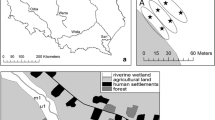Abstract
The fringing reeds (Phragmites australis (Cav.) Trin. ex Steud., Poaceae) at Lake Constance-Untersee were mown or burnt in winter thereby drastically reducing the addition of decomposable organic matter to the sediment. The purpose of this study was to test whether or not this management significantly decreased the contents of organic matter and nutrients in the surface sediment layer and if the oxygen conditions in the withinreed water body improved. Hypotheses were tested by monitoring 6 treated reed beds and 3 reference fields over a period of up to 4 years. The sediment/water system of reed beds was found to be well buffered against the removal of the current year's crop of dead Phragmites straw, because only slight, and mostly insignificant, differences between treated and untreated reeds were detected. Hence, the benefit of winter reed harvesting to reduce nutrient overloading of the reed-belts and the ‘die-back’ of reeds remains dubious.
Similar content being viewed by others
References
Banoub, M.W. 1975. Experimental studies on material transactions between mud and water of the Gnadensee (Bodensee). Verb. Int. Ver. Limnol. 19: 1263–1271.
Delaune, R.D. and Patrick, W.H. 1980. Nitrogen and phosphorus cycling in a gulf coast salt marsh. In: Kennedy, VS. (ed) Estuarine perspectives. pp. 143–151. Academic Press, New York
DEV 1981–85. German standard methods for the examination of water, wastewater and sludge. Verl. Chemie, Weinheim.
Esteves, F.A. de 1980. Die Bedeutung der aquatischen Makrophyten für den Stoffhaushalt des Schöhsees. III. Die anorganischen Hauptbestandteile der aquatischen Makrophyten. Gewässer u. Abwässer 66,67: 29–94.
Frevert, T. 1983. Hydrochemisches Grundpraktikum. Birkhäuser (UTB 1256), Basel
Graneli, W. 1990. Standing crop and mineral content of reed, Phragmites australis (Cav.) Trin. ex Steudel, in Sweden — Management of reed stands to maximize harvestable biomass. Folia Geobot. Phytotax. 25: 291–302.
Hammer, L. 1985. Das Problem der Eutrophie im Neusiedler See. Wiss. Arb. Burgenland (Eisenstadt) 72: 341–371.
Hansson, L.A. and Graneli, W. 1984. Effects of winter harvest on water and sediment chemistry in a stand of reed (Phragmites australis). Hydrobiologia 112: 131–136.
Hillbricht-Ilkowska, A. and Pieczynska, E. (ed) 1993. Nutrient dynamics and retention in land/water ecotones of lowland, temperate lakes and rivers. Hydrobiologia 251: XIV +61 pp.
Howard-Williams, C. 1985. Cycling and retention of nitrogen and phosphorus in wetlands: a theoretical and applied perspective. Freshwater Biology 15: 391–431.
Klötzli, F. and Züst, S. 1973. Nitrogen regime in reed beds. Pol. Arch. Hydrobiol. 20: 131–136.
Meissner, P. and Ostendorp, W. 1988. Em Strömungsmodell der temperaturinduzierten Dichteströmung in geschlossenen Uferröhrichten des Bodensee-Untersees. Arch. Hydrobiol. 112:433–448.
Metz, H. 1985. Zur Phosphor- und Stickstoffsituation im Schilfgürtel des Neusiedler Sees. Wiss. Arb. Burgenland (Eisenstadt) 72:311–339.
Ostendorp, W. 1987. Die Auswirkungen von Mahd und Brand auf die Uferschilfbestände des Bodensee-Untersees. Natur u. Landschaft 62: 99–102.
Ostendorp, W. 1991. Die Ursachen des Röhrichtrückgangs am Bodensee-Untersee. Carolinea 48: 85–102.
Ostendorp, W. 1992. Sedimente und Sedimentbildung in Seeuferröhrichten des Bodensee-Untersees. Limnologica 22: 16–33.
Ostendorp, W. 1993. Schilf als Lebensraum. Beih. Veröff. Natursch. Landschaftspfl. Bad. -Württ.(Karlsruhe) 68: 173–280.
Ostendorp, W. 1995: Effect of management on the mechanical resistance of lakeside reeds in Lake Constance. Acta Oecol. 16 (in press)
Polunin, N.V. 1982. Processes contributing to the decay of reed (Phragmites australis) litter in fresh water. Arch. Hydrobiol. 94: 182–209.
Richardson, C.J., Tilton, D.L., Kadlec, J.A., Chemie, J.P.M. and Wentz, W.A. 1978. Nutrient dynamics of northern wetland ecosystems. In: Good, R.E. Whigham, D.F. and Simpson, R.L. (ed) Freshwater Wetlands. Ecological Processes and Management Potentials. pp. 217–241. Academic Press, New York.
Rodewald-Rudescu, L. 1974. Das Schilfrohr. Die Binnengewässer 27: 1–302.
Schröder, R. 1973. Die Freisetzung von Pflanzennährstoffen im Schilfgebiet und ihr Transport in das Freiwasser am Beispiel des Bodensee-Untersees. Arch. Hydrobiol. 71:145–158.
Schröder, R. 1979. The decline of reed swamps in Lake Constance. Symp. Biol. Hung. 19:43–48.
Schröder, R. 1987. Das Schilfsterben am Bodensee-Untersee. Beobachtungen, Untersuchungen und Gegenmaßnahmen. Arch. Hydrobiol. Suppl. 76: 53–99.
Sieghardt, H. and Maier, R. 1985. Produktionsbiologische Untersuchungen an Phragmites-Bestanden im geschlossenen Schilfgürtel des Neusiedler Sees. Wiss. Arb. Burgenland (Eisenstadt) 72: 189–221.
Tóth, L. and Szabó, E. 1958. Über die chemische Zusammensetzung verschiedener Schilfproben vom Balaton-See. Ann. Biol. Tihany 25: 363–374.
van der Linden, M.J.H.A. 1980. Nitrogen economy of reed vegetation in the Zuidelijk Flevoland Polder. I. Distribution of nitrogen among shoots and rhizomes during the growing season and loss of nitrogen due to fire management. Acta Oecol. 1: 219–230.
van der Linden, M.J.H.A. 1986: Phosphorus economy of reed vegetation in the Zuidelijk Flevoland Polder (The Netherlands): seasonal distribution of phosphorus among shoots and rhizomes and availability of soil phosphorus. Acta Oecol./Oecol. Plant. 7:397–405.
Webster, J.R. and Benfield, E.F. 1986. Vascular plant breakdown in freshwater ecosystems. Ann. Rev. Ecol. Syst. 17: 567–594.
Woodmansee, R.G. and Wallach, L.S. 1981: Effect of fire regimes on bio-geochemical cycles. In: Clark, F.E. and Rosswall, T. (ed) Terrestrial Nitrogen Cycles. Ecol. Bull. (Stockholm) 33: 649–670.
Author information
Authors and Affiliations
Rights and permissions
About this article
Cite this article
Ostendorp, W. Impact of winter reed harvesting and burning on the nutrient economy of reed beds. Wetlands Ecol Manage 3, 233–248 (1995). https://doi.org/10.1007/BF00179839
Issue Date:
DOI: https://doi.org/10.1007/BF00179839




